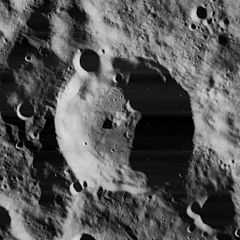Wexler (crater)
|
Lunar Orbiter 4 image | |
| Coordinates | 69°06′S 90°12′E / 69.1°S 90.2°ECoordinates: 69°06′S 90°12′E / 69.1°S 90.2°E |
|---|---|
| Diameter | 51 km |
| Depth | Unknown |
| Colongitude | 272° at sunrise |
| Eponym | Harry Wexler |
Wexler is a lunar impact crater that lies across the south-southeast limb of the Moon. In this location not much detail about the formation can be discerned from the Earth, and it must be viewed from orbit to see most of the structure. It lies about a hundred kilometers northwards of the larger crater Hale, and south-southeast of Petrov.
The rim of this crater retains much of its original structure, although the features have become softened and worn in comparison to the younger Hale. The rim has a polygonal appearance along most of the perimeter, and traces of terraces can still be seen along sections of the inner wall. There is a small crater across the northwest rim, but otherwise the formation is not significantly marked by impacts. The interior floor is relatively flat and level, with a central peak near the midpoint. There is the ghostly remnant of a crater to the northeast of the middle peak.
Within a half crater diameter to the north and east is a wide, valley-like rift in the surface. The narrow end of this cut is located to the east of Wexler, and from there it follows a nearly straight, widening course to the northeast, before opening wide towards the northwest to the north of Wexler.
Satellite craters
By convention these features are identified on lunar maps by placing the letter on the side of the crater midpoint that is closest to Wexler.
| Wexler | Latitude | Longitude | Diameter |
|---|---|---|---|
| E | 68.8° S | 95.5° E | 23 km |
| H | 70.5° S | 96.7° E | 14 km |
| U | 68.2° S | 82.0° E | 51 km |
| V | 68.0° S | 83.9° E | 21 km |
References
- Andersson, L. E.; Whitaker, E. A. (1982). NASA Catalogue of Lunar Nomenclature. NASA RP-1097.
- Blue, Jennifer (July 25, 2007). "Gazetteer of Planetary Nomenclature". USGS. Retrieved 2007-08-05.
- Bussey, B.; Spudis, P. (2004). The Clementine Atlas of the Moon. New York: Cambridge University Press. ISBN 978-0-521-81528-4.
- Cocks, Elijah E.; Cocks, Josiah C. (1995). Who's Who on the Moon: A Biographical Dictionary of Lunar Nomenclature. Tudor Publishers. ISBN 978-0-936389-27-1.
- McDowell, Jonathan (July 15, 2007). "Lunar Nomenclature". Jonathan's Space Report. Retrieved 2007-10-24.
- Menzel, D. H.; Minnaert, M.; Levin, B.; Dollfus, A.; Bell, B. (1971). "Report on Lunar Nomenclature by the Working Group of Commission 17 of the IAU". Space Science Reviews 12 (2): 136–186. Bibcode:1971SSRv...12..136M. doi:10.1007/BF00171763.
- Moore, Patrick (2001). On the Moon. Sterling Publishing Co. ISBN 978-0-304-35469-6.
- Price, Fred W. (1988). The Moon Observer's Handbook. Cambridge University Press. ISBN 978-0-521-33500-3.
- Rükl, Antonín (1990). Atlas of the Moon. Kalmbach Books. ISBN 978-0-913135-17-4.
- Webb, Rev. T. W. (1962). Celestial Objects for Common Telescopes (6th revision ed.). Dover. ISBN 978-0-486-20917-3.
- Whitaker, Ewen A. (1999). Mapping and Naming the Moon. Cambridge University Press. ISBN 978-0-521-62248-6.
- Wlasuk, Peter T. (2000). Observing the Moon. Springer. ISBN 978-1-85233-193-1.
